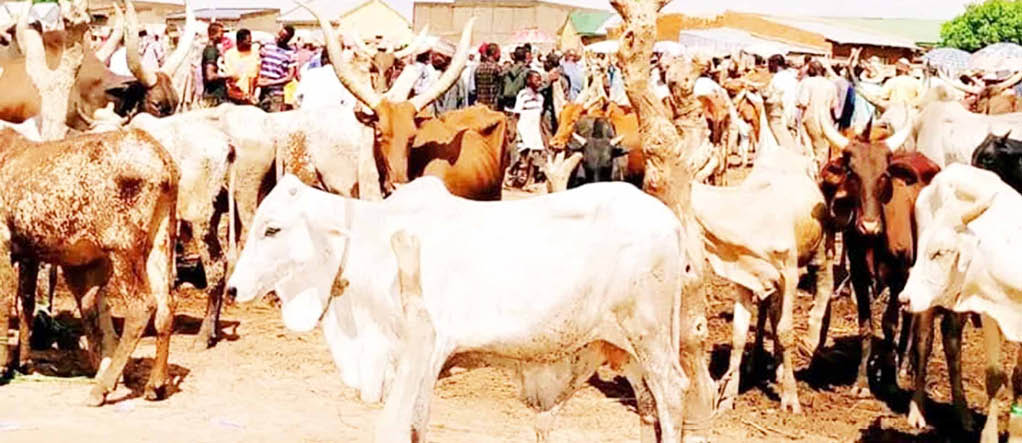Is cattle herding outdated?
In spite of the farmer-herder crisis in Nigeria, the narrative that cattle herding is an outdated global practice needs to be corrected. Herding is a Fulani culture, and it should be appreciated, not frowned upon, as recently demonstrated by the United Nations Educational, Scientific and Cultural Organisation (UNESCO). Herding is about moving livestock over long […]

A cattle market in the state
In spite of the farmer-herder crisis in Nigeria, the narrative that cattle herding is an outdated global practice needs to be corrected.
Herding is a Fulani culture, and it should be appreciated, not frowned upon, as recently demonstrated by the United Nations Educational, Scientific and Cultural Organisation (UNESCO). Herding is about moving livestock over long distances to new grazing locations by Fulani herders. The cattle are meant to feed on scrub and grasses in land unsuitable for farming. The journey can span several weeks or even months, covering significant distances.
Herders move their cattle from the drier North to the greener central and southern regions during the dry season and back again when the rains return to the North. The practice requires careful planning and knowledge of the routes and resources along the way. It is characterised by the challenges of the journey, passing through different terrains, like farms, and dealing with weather and other environmental factors. The Fulani rely on cattle for milk and rarely slaughter the animals for meat.
However, the practice has brought a never-ending farmer-herder conflict to Nigeria. This conflict springs from competition for scarce land and water, intensified by climate changes and agricultural expansion. Ethnic and religious differences, economic pressures, insecurity, and political factors compound this tension between Fulani herders and farmers. The conflict has led to violence, causing significant losses and displacement, and requires solutions that integrate resource management, community reconciliation, and equitable policies.
ICT tools that can help Nigeria tackle kidnappings, banditry
Your actions are anti-people, LP candidates berate Soludo
Nonetheless, it does not warrant educators, policymakers and political leaders to keep misleading the public by saying herding is outdated. It is not. We can agree that it has evolved, but it is still in practice across the world. Just last month, December 2023, UNESCO inscribed seasonal transhumance, a form of herding, in ten European countries as an Intangible Cultural Heritage of Humanity. The countries are Albania, Andorra, Austria, Croatia, France, Greece, Italy, Luxembourg, Romania and Spain.
With transhumance, herders follow a seasonal migration pattern, usually moving to cool highlands in the summer and warmer lowlands in the winter. Similar to our Fulani nomads, these herders move between the same two locations, where they have permanent settlements. One can find online videos of these herders being celebrated whenever they pass through towns and villages with their animals in droves. On the contrary, many Nigerians will find it hard to believe that the seasonal livestock movement is celebrated and preserved for its cultural and environmental significance in Europe. This is the result of misinformation.
Another form of herding that still exists in the Western World is the traditional droving in Australia. It was once the backbone of the rural economy, especially during the drought when cattle must be moved to areas with better feed and water. Unlike Nigeria, the Australian droving is now romanticised as part of the country’s cultural heritage, with its iconic stock routes being a symbol of rural life and history. Similarly, in Argentina, the gaucho culture epitomises the country’s version of herders. Gauchos are similar to the North American cowboy. They historically manage vast herds of cattle on the grasslands. Despite of the Argentine pastoral system into ranching operations, the gaucho remains a cultural icon, with traditional skills and knowledge still valued in rural areas.
Coming into Africa, the Maasai, Samburu, and Turkana offer valuable lessons for Nigeria in maintaining its herding culture. Herding in Kenya is not just an economic activity but a cultural identity, with communities practising nomadic or semi-nomadic livestock rearing adapted to the challenges of arid and semi-arid regions. The key to their approach is the integration of traditional knowledge with modern sustainable practices, addressing challenges like climate change, land degradation, and resource competition.
Community-based conflict resolution, land use management, and climate adaptation strategies, such as water harvesting and drought-resistant pastoral systems, are pivotal. Nigeria can draw from this by encouraging sustainable herding practices, enhancing community engagement, and implementing policies that support pastoralists’ livelihoods while ensuring environmental conservation. Such a holistic approach would help Nigeria maintain its herding culture, vital for the socio-economic fabric of many communities, while addressing contemporary challenges.
We must acknowledge the roles played by the continuous expansion of urban areas and technological advancement in the country. These factors have led many people to cast traditional herding practices as outdated, putting them at odds with contemporary development goals. The view is enhanced by the never-ending conflicts between farmers and herders, which frame herding as a factor contributing to instability and insecurity. But as highlighted, this perspective is not solely a Nigerian phenomenon.
We cannot just strike out our culture when we can use global good practices to solve the ongoing conflicts. Therefore, discussions must continue to modernise and integrate pastoral practices sustainably within the national economic framework.
UNESCO’s designation of transhumant herders as an Intangible Heritage of Humanity illustrates the recognition of the cultural and environmental value of herding practices. The challenge, now, is to appreciate our heritage within the imperatives of modernity.
